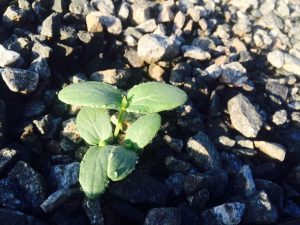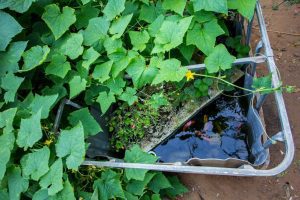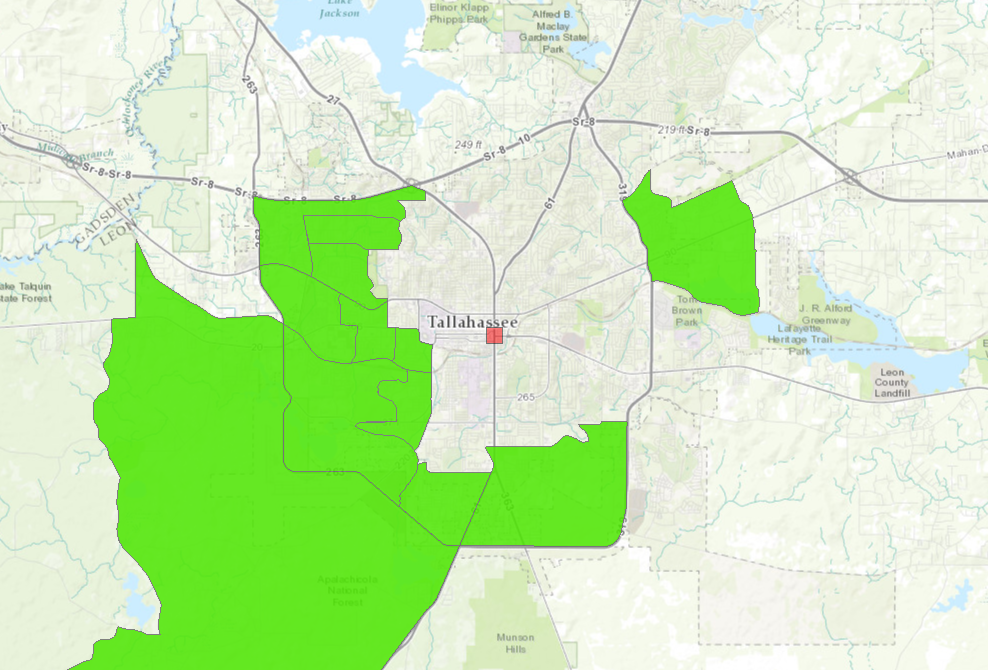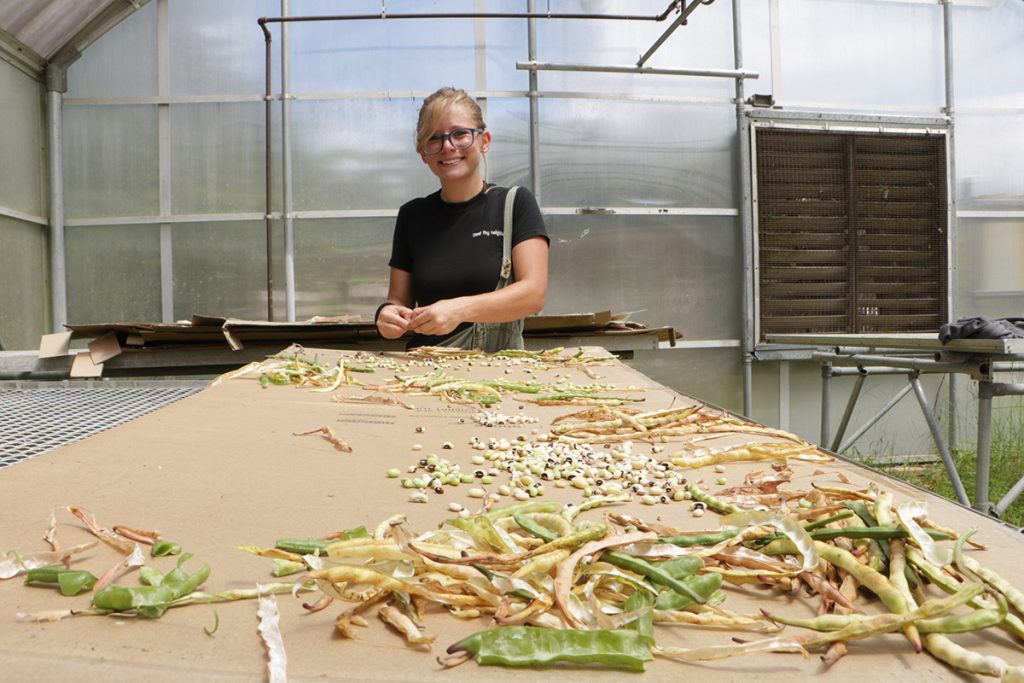In today’s video, we look at a school garden that feeds and educates students. We also look at different community efforts looking to bring nutritious food to Tallahassee residents living in food deserts.
Rob Diaz de Villegas WFSU-TV
Today on the menu at the Success Academy: black eyed peas. It’s not a main dish, but possibly the most interesting. It’s the first time the cafeteria is serving food grown in the Success Academy garden.
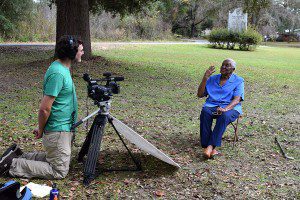
WFSU Producer Rob Diaz de Villegas interviews Dr. Flossie Byrd, author of “Echoes of a Quieter Time”.
Watching the students pick the pea pods in the heat of a late summer afternoon, I can’t help but think about a video I produced earlier this year, a part of our Roaming the Red Hills series. In it, Dr. Flossie Byrd recalls her 1940s upbringing in Monticello, Florida. Many of her schoolmates worked on their family’s farms. Some of their produce ended up in the classroom, where the teacher and students cooked it for lunch.
In her book, Echoes of a Quieter Time, Dr. Byrd (Education Psychology PhD. from Cornell) lists the many successes of her fellow students. The education they received in the segregated South seems both old school and ahead of its time. Her teachers didn’t know that they were practicing such modern concepts as “STEM education” and sustainable “Farm to Table” eating.
Success Academy teacher Sean Willett, however, is fully aware of these concepts. Leon County Public Schools’ Success Academy is a second chance school. To catch up on credits, students spend a lot of time at desks, at computers. The faculty thought students needed more outdoor time, and yet they don’t have a lot of time to spare.
“We had to include something that included getting their hands out and dirty, and working,” Mr. Willett says, “but [where] they were also learning.”
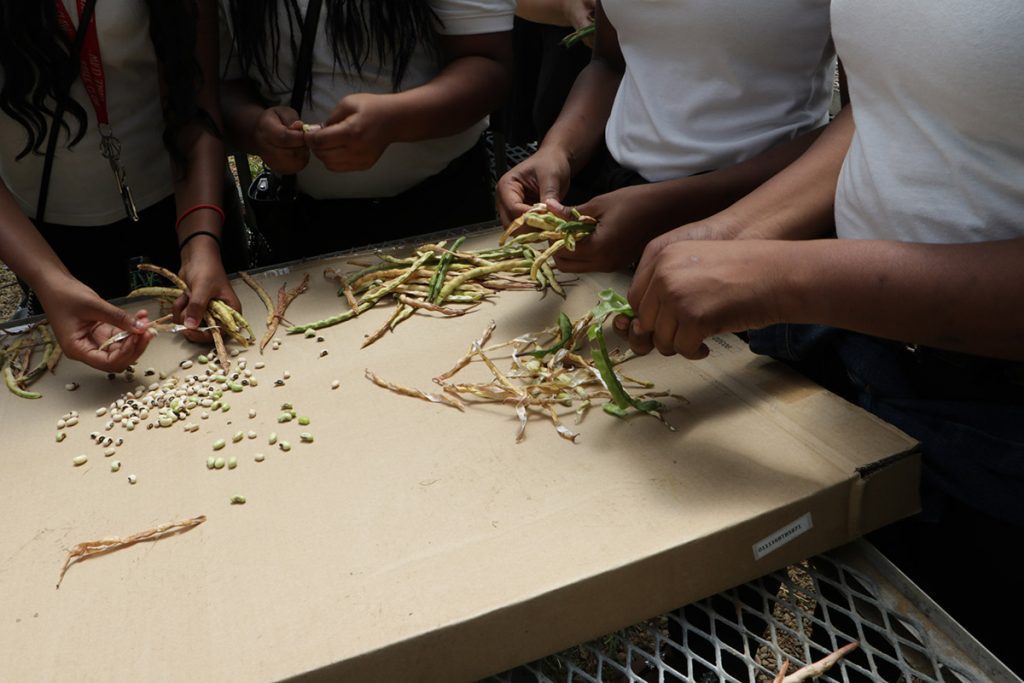
Students shuck black eyed peas grown in the Success Academy garden. The peas were then taken to the cafeteria, where they were cooked and served to students.
Aquaponics | STEM Garden Tool
Not that students are always getting their hands dirty in the Success Academy garden.
Michele Madison stands by a bed of rocks attached to what looks like a small plastic Koi pond. “I don’t think I’ve ever had a better cucumber than a cucumber out of an aquaponics system.”
Michele runs a nonprofit called Farming the Future. They build aquaponics systems in schools located in Leon County. In aquaponics, plants grow directly in a bed of rocks.
The fish in that plastic tub create what I guess you could call “fish manure.” That in turn creates nutrient rich water. That water floods the rock bed, coating the rocks with nitrogen.
A bell siphon regulates the amount of water in the bed. When the water reaches a certain level, the siphon creates a vacuum that drains the bed. Now the roots receive oxygen. When the bed is empty, air bubbles rise up through the pipes and suck the water back up, bringing water back to the roots.
The plants consume the nutrients in the water, cleaning it for the fish. It is, as Michele says in the video, a symbiotic relationship.
Aquaponics uses the same biological processes that make plants grow in soil, and uses engineering to make it happen. It’s a multifaceted teaching tool. And it makes nutritious food.
Michele sounds like a person who has found her dream job. “It brings people together,” she says, “and it gets people excited about growing their own food… This is the future.”
The Availability of Healthy Food
When Michele references the future, she is partly talking about using design and engineering to sustainably feed people. But there is also the idea that communities can take control of their food needs.
“In this school, a lot of students live in food deserts,” Michele says. “And they don’t have access to good, nutritional food.”
Below is a map of food deserts in Tallahassee, created using the US Department of Agriculture (USDA) Food Access Research Atlas:
The USDA defines a food desert as a “low-income census tract where either a substantial number or share of residents has low access to a supermarket or large grocery store.” A low income tract is one in which 20% of the population is below federal poverty levels. If 33% of people in the tract are more than a mile from a grocery store, that’s considered low access (10 miles in rural areas).
In other words, these are places where people might have trouble affording fresh fruits and vegetables. And, they have to travel further to seek out this healthier food.
“Maybe you should cut back on the prices of how healthy food, how much it costs.” Says Success Academy student Maleek Cole. “Junk food ain’t really that much, so it’s like, get something quick and simple.”
A number of nonprofits are, however, working to get healthy food to more people in Tallahassee.
Community Garden Efforts & More
Below is a list of programs that look to bring healthy, affordable food to areas of concern.
Frenchtown Farmers Market
Every Saturday from 9 am to 2 pm, local growers sell “a wide variety of fresh, local, naturally grown produce, honey, eggs, baked goods, gourmet preserves and smoked meat.” On the USDA map, Frenchtown is not considered a food desert. But, it is a low income Census tract. It’s the only farmer’s market in the area to accept SNAP Benefits (formerly food stamps). In fact, at the Frenchtown Market, every SNAP dollar is worth double its value.
iGrow- Whatever You Like
Empowering young people is the at the heart of the iGrow mission. It is a working farm run by teens, and it has two locations: The original Frenchtown farm and one more recently opened in South City.
They sell produce at both locations on Mondays and Fridays. Whatever they don’t sell, They donate to charities like Second Harvest. They also sell products like the iGrow Bucket, raised beds, and compost to encourage urban gardening, and offer workshops.
They’ve been fairly successful since their inception in 2011, selling their produce on Red Hills Online Market and to local restaurants such as the Miccosukee Root Cellar, Kool Beanz, Sweet Pea Cafe, and Cypress.
Community Gardens in Tallahassee
iGrow is an initiative of the Tallahassee Food Network. The TFN also partners with the City of Tallahassee to facilitate the creation of community gardens.
You can search for a parcel of city owned land in your neighborhood, and put in an application. The city will even install a water meter on the parcel.
There are, of course, rules governing community gardens. And it is a commitment. But it does seem like a good way to bond with neighbors, and grow some tasty food.
Farming and Education
The first time we met Maleek Cole, it was also in a farm setting. Good Taste Tally is a farm founded by FSU education professor, Dr. George Boggs. Kind of like iGrow, the farm is run by teens. In this case it’s a group from 50 Large, a Leon County Public Schools program for at risk youth. The students we interviewed attended the Success Academy as well.
Good Taste Tally combines the educational goals of the Success Academy garden with the entrepreneurship ideals of iGrow. There are definite benefits to having kids work with their hands, outdoors. It’s not a benefit that can be measured by standardized testing.
The Success Academy is the only public school in Leon County where Farming the Future has installed an aquaponics system. There is one at Cornerstone Learning Community, and Michelle told us that they were building units at the Magnolia School and at the Department of Juvenile Justice.
Cornerstone in particular embraces the connection between education and agriculture. Students maintain gardens and raise chickens on the campus, and make monthly visits to Longview Farm.
The Sustainability of Aquaponics
We didn’t have space for this in the video, but I thought it was worth sharing. Michele Madison gave us a few reasons that aquaponics is more ecologically friendly than traditional farming:
- You can’t use pesticides, because it would kill the fish. If the plants get aphids, she said, they close the greenhouse and release ladybugs.
- It uses 1/10 the water as traditional agriculture. It’s a closed system that makes use of constantly recirculating water. They do use the nitrogen rich system water to water seedlings, so there is some need to replenish the tank.
- Because it’s a closed system, it doesn’t threaten local waterways. Depending on their use of fertilizers, farms are a source of excess nitrogen in waterways.

